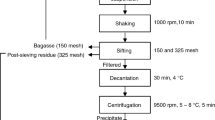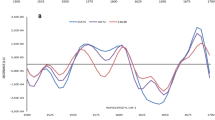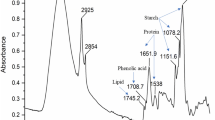Abstract
Amaranth nutritional value has been widely recognized, but the required conditions for its processing cannot be adapted to traditional technologies. For the proposal of alternative strategies, the changes of several components should be understood. Enriched starch and lipid–protein fractions of amaranth flour upon different milling treatments were obtained and characterized by attenuated total reflectance–Fourier transform-infrared spectroscopy. Starch- and lipid–protein-enriched amaranth fractions were obtained by abrasive milling; amaranth starch was isolated by wet-milling procedure, and flour samples were obtained from planetary ball milling. Changes on starch, protein, and lipids relative contents, on starch crystallinity and on lipids and protein stability after milling and 6-month storage, were evaluated. The Fourier transform-infrared (FT-IR) spectroscopy peaks of the main grain components were identified in the middle-infrared range. By calculating the ratios between height intensities of selected specific peaks, several characteristics of the samples could be explained: increased protein content and lipid proportion of the enriched fraction; decrease of the starch crystallinity degree by abrasive milling and especially by ball milling due to starch amorphization during these processes; and lipids modification in milled and in 6-month aged samples. FT-IR analysis can be considered a rapid, nondestructive, solvent-free, sensitive, and useful tool to investigate starch, lipid, and protein modifications provoked by processing and storage as well as to determine, based on intensity ratio, the relative proportion of grain components within amaranth milling fractions. The abrasive milling associated to planetary ball milling to obtain modified different fractions is presented as an interesting strategy for the processing of amaranth grain.






Similar content being viewed by others
References
AACC 76–11. (1995). Starch content method. Approved methods of the AACC (9th ed.). St Paul: American Association of Cereal Chemistry.
Achouri, A., Nail, V., & Boye, J. (2012). Sesame protein isolate: fractionation, secondary structure and functional properties. Food Research International, 46, 360–369.
AOAC 923.03. (2005). Ash of flour. Official methods of analysis, 18th ed. Association of Official Analytical Chemists: Gaithersburg, MD.
AOAC 925.09. (2000). Solids (total) and moisture in flour. Official methods of analysis, 17th edn. Association of Official Analytical Chemists: Gaithersburg, MD.
AOAC 925.12. (2005). Acid hydrolysis method. Official methods of analysis, 18th edn. Association of Official Analytical Chemists: Gaithersburg, MD.
AOAC 960.52. (2005). Microchemical determination of nitrogen. Official methods of analysis, 18th edn. Association of Official Analytical Chemists: Gaithersburg, MD.
Barth, A. (2007). Infrared spectroscopy of proteins. Biochimica et Biophysica Acta, 1767, 1073–1101.
Basavarajappa, B. S., Shetty, H. S., & Prakash, H. S. (1991). Membrane deterioration and other biochemical changes, associated with accelerated aging of maize seeds. Seed Science Technology, 19, 279–286.
Calucci, L., Capocchi, A., Galleschi, L., Ghiringhelli, S., Pinzino, C., Saviozzi, F., & Zandomeneghi, M. (2004). Antioxidants, free radicals, storage proteins, puroindolines, and proteolytic activities in bread wheat (Triticum aestivum) seeds during accelerated aging. Journal of Agricultural and Food Chemistry, 52, 4274–4281.
Calzetta Resio, N. (2007). Wet-milling of amaranth grain (A. cruentus). Study of the effects of processing conditions on yield and quality of its products and properties of the starchy fraction. PhD Thesis. Buenos Aires, Argentina: Department of Industry, University of Buenos Aires.
Calzetta Resio, N., Tolaba, M., & Suárez, C. (2006). Effects of steeping conditions on wet-milling attributes of amaranth. International Journal of Food Science and Technology, 41(2), 70–76.
Capron, I., Robert, P., Colonna, P., Brogly, M., & Planchot, V. (2007). Starch in rubbery and glassy states by FTIR spectroscopy. Carbohydrate Polymers, 68, 249–259.
Cremer, D., & Kaletunç, G. (2003). Fourier transform infrared microspectroscopy study of the chemical microstructure of corn and oat flour-based extrudates. Carbohydrate Polymers, 52, 53–65.
Doblado-Maldonado, A. F., Pike, O. A., Sweley, J. C., & Rose, D. J. (2012). Key issues and challenges in whole wheat flour milling and storage. Journal of Cereal Science, 56, 119–126.
Jiménez-Elizondo, N., Sobral, P. J. A., & Menegalli, F. C. (2009). Development of films based on blends of Amaranthus cruentus flour and polyvinyl alcohol. Carbohydrate Polymers, 75, 592–598.
Jiugao, Y., Ning, W., & Xiaofei, M. (2005). The effects of citric acid on the properties of thermoplastic Starch plasticized by glycerol. Starch-Starke, 57, 494–504.
Liu, T., Ma, Y., Yu, F., Shi, J., & Xue, S. (2011). The effect of ball milling treatment on structure and porosity of maize starch granule. Innovative Food Science and Emerging Technologies, 12(4), 586–593.
Lopez-Rubio, A., Flanagan, M., Shrestha, A., Gidley, M., & Gilbert, E. (2008). Molecular rearrangement of starch during in-vitro digestion: towards a better understanding of enzyme resistant starch formation. Biomacromolecules, 9, 1951–1958.
Martínez-Bustos, F., López-Soto, M., San Martín-Martínez, E., Zazueta-Morales, J., & Velez-Medina, J. (2007). Effects of high energy milling on some functional properties of jicama starch (Pachyrrhizus erosus L. Urban) and cassava starch (Manihot esculenta Crantz). Journal of Food Engineering, 78, 1212–1220.
Peiretti, G. (2009). Becoming real a new crop—25 years promoting the future of amaranth. In: Proceedings of the Amaranth Symposium, 22–23 October 2009. Buenos Aires, Argentina: La Plata. Book.
Prabhasankar, P., & Rao, P. H. (2001). Effect of different milling methods on chemical composition of whole wheat flour. European Journal of Food Research and Technology, 213, 465–469.
Roa-Acosta, D., Loubes, M., Baeza, R. & Tolaba, M. (2011). Following amaranth pearling by means of image analysis. In: Proceeding of Congreso Argentino de Ciencia y Tecnología de Alimentos, 19–21 October 2011, Buenos Aires, Argentina (CD-ROM).
Sevenou, O., Hill, S. E., Farhat, I. A., & Mitchell, J. R. (2002). Organization of the external region of starch granules as determined by infrared spectroscopy. International Journal of Biological Macromolecules, 31, 79–85.
Shrestha, K., Ng, C., Lopez-Rubio, A., Blazek, J., Gilbert, E., & Gidley, M. (2010). Enzyme resistance and structural organization in extruded high amylose maize starch. Carbohydrate Polymers, 80(3), 699–710.
Tapia-Blácido, D. (2006). Edible films based on amaranth flour and starch. PhD Thesis. Department of Food Engineering, Campinas-SP, Brazil.
Tosi, E., Re, E., Lucero, H., & Masciarelli, R. (2000). Amaranth (Amaranthus spp.) grain conditioning to obtain hyperproteic flour by differential milling. Food Science and Technology International, 5, 60–63.
Xie, X., Liu, Q., & Cui, S. W. (2006). Studies on the granular structure of resistant starches (type 4) from normal, high amylose and waxy corn starch citrates. Food Research International, 39, 332–341.
Zhang, Z., Zhao, S., & Xiong, S. (2010). Morphology and physicochemical properties of mechanically activated rice starch. Carbohydrate Polymers, 79, 341–348.
Acknowledgments
The authors acknowledge the financial support from PME-2006-01685, UBACYT (Project UBACyT 20020100100397 and 20020110200357), CONICET (PIP 100846), and ANPCYT (PICT 0928). PRS and MPB are members of CONICET.
Author information
Authors and Affiliations
Corresponding author
Rights and permissions
About this article
Cite this article
Roa, D.F., Santagapita, P.R., Buera, M.P. et al. Amaranth Milling Strategies and Fraction Characterization by FT-IR. Food Bioprocess Technol 7, 711–718 (2014). https://doi.org/10.1007/s11947-013-1050-7
Received:
Accepted:
Published:
Issue Date:
DOI: https://doi.org/10.1007/s11947-013-1050-7




